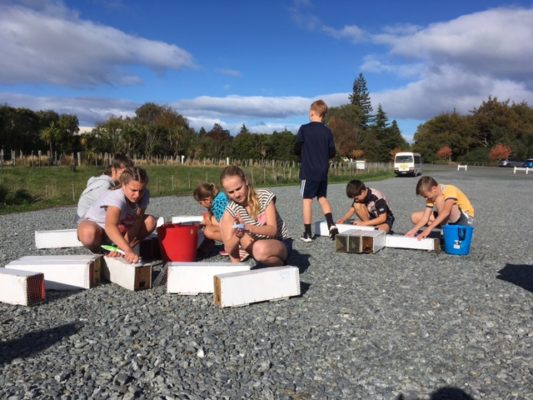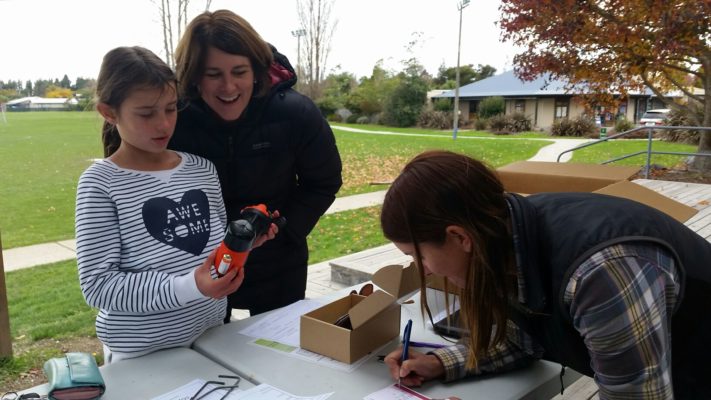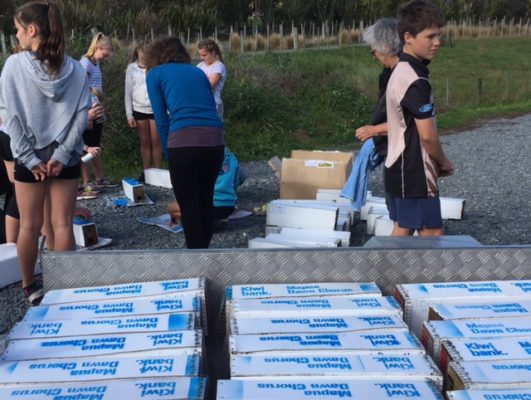Mapua Dawn Chorus held an open day recently to kick off their backyard trapping. There’s already an extensive trapping network around the nearby Waimea estuary, but with funding from the Predator Free Communities programme the Mapua Dawn Chorus are extending into the township of Mapua.
The open day was on a Saturday when a lot of people were gathered to watch the local football match in the field beside the Community Hall. Unfortunately they also picked a day when a Pilates class was being held in the hall – so the Mapua Dawn Chorus volunteers found themselves outside in the cold with the soccer fans.
“It was a freezing cold day,” says volunteer coordinator Abby Boffa, “but we had lots of people coming through.”
When we spoke to Abby she was undeterred by the icy beginning and planning another open day for June.

Mapua Dawn Chorus has already had some keen helpers from Mapua School. They’ve been cleaning old trapping tunnels that were donated to the group after being in a shed for a couple of years and spray-painting on stencilled logos. It’s good fun for a good cause. The school has a strong environmental education programme and are keen to be involved.
“Mapua School is part of Tane’s Ark,” Abby explains. “They’ve been involved in the replanting and restoration programme for a number of years.”
Tane’s Ark is a joint initiative between the ‘Friends of Mapua Wetlands’ group and Mapua School to restore an area of Aranui Park adjacent to the Mapua Wetlands. As part of their school work, children learn about how to be ‘good kaitiaki’ and the role pest control plays in this.
“I’ve been and talked to classes about the types of traps we’re using,” says Abby. “I gave out chew cards and they made their own tracking tunnels. They wanted to know about the ‘biggest rat’ and the ‘weirdest’.”
There’s been good interest from the wider Mapua community too.
“A lot of people have been reporting rat issues,” says Abby. “I’ve personally caught two rats in five days. I got a Goodnature trap last August and I’ve taken at least 20 rats. The rats are caught in waves,” Abby adds. “I catch a few, then there is a gap for a few weeks.”
As more and more of the community take up rat-trapping, reinvasion of rats from neighbouring properties should noticeably decrease.

“At the open days people are generally interested in predator control,” says Abby. “At the first open day we sold 20 Goodnature A24 traps with orders for another six or seven and we’ve sold 35 Victor traps and tunnels.”
A follow-up to the open days is also planned.
“The next stage will be to approach households in areas where there is not much coverage,” says Abby.
Monitoring of results from the predator control programme is also on the agenda.
“In spring we plan to carry out bird surveys and we’ll also be doing chew card monitoring each quarter to see how heavily we’re hitting predators and whether we need more density of traps.”
There is a lot of birdlife around Mapua and Abby finds local people are generally keen to protect their birds. Some rather special birds have even achieved fame beyond Mapua’s boundaries.
“Hamish the white heron was famous,” says Abby. “He came to the area to winter over every year from the 1980s on. He had been coming for about 20 years and only stopped in 2011, presumably because of his old age. It made the news when Hamish didn’t come back.”
The town has a statue of a white heron on a wharf pile in memory of the well-loved bird who used to pinch bait from fishermen on the wharf. Tui, bellbirds and fantails are, however, the native birds more commonly seen in Mapua gardens. At the moment Mapua Dawn Chorus is primarily focussing on trapping rats in the urban area.
“If anyone is having issues with stoats or possums we’ll support them,” says Abby, “But they’re not a big issue in the urban environment.”

Mapping where traps are, is one of the next tasks on Abby’s agenda as part-time co-ordinator for the project.
“I’ll be looking at highlighting where traps are and what sort. I also need to find out what existing traps are already in the community,” she says. “I’ll use social networks like the Mapua Community Association to get in touch with people. We’re ideally aiming for traps in 1 in every 4 backyards. Once we know what’s out there, we can work out what gaps there are to plug.”
Support for the trapping programme is also coming from nearby Richmond.
“There’s a guy in Richmond, Don Sullivan who makes trap tunnels form corflute real estate sale signs,” says Abby. “You let him know you need some and he gives them away. He’s been doing it for about 10 years and gets about 3 tunnels out of every sign. It’s good to see the old signs used productively,” she adds.
Don ships his corflute tunnels all over New Zealand and has been a keen conservationist for many years. He estimates he’s made about 6000 trap tunnels in his Richmond basement.
From primary school pupils, to retired volunteers, all ages are coming together to battle rats and protect Mapua’s birdlife. Bringing communities like this together in a common cause – that’s what Kiwibank Predator Free Communities is all about. Well done Mapua – and thanks again, Kiwibank.

